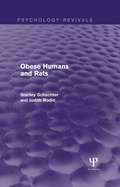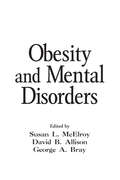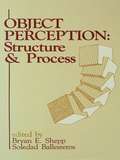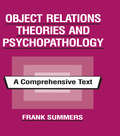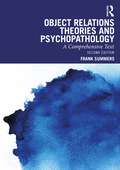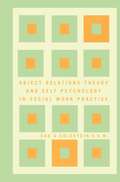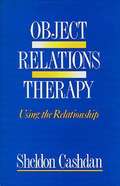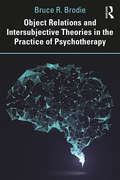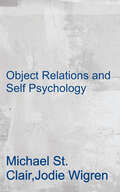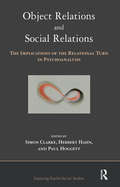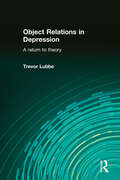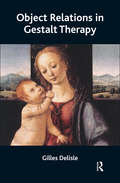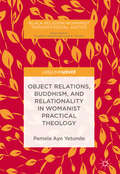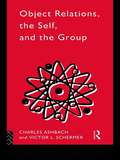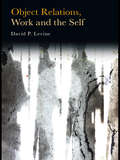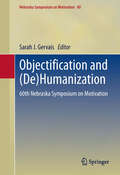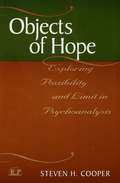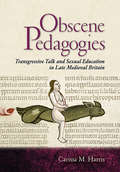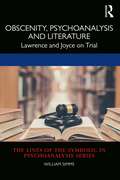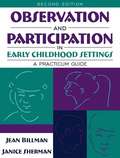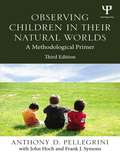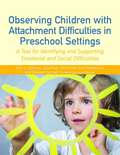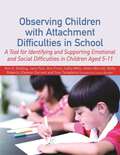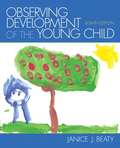- Table View
- List View
Obese Humans and Rats (Psychology Revivals)
by Judith Rodin Stanley SchacterOriginally published in 1974, this volume examines the behavioural similarities of obese humans and animals whose so-called feeding centre (the ventro-medial hypothalamic nuclei) has been lesioned. Both the obese human and the VMH-lesioned animal seem to share a hyposensitivity to the internal (physiological) cues to eating and hypersensitivity to external cues associated with food. Beginning with a review, these obese animals and the human obese are compared point by point on experimental results reported in the literature. Then, new findings are presented that specifically tested humans for relationships that are well-established for lesioned animals. Next, a theoretical framework integrates the human and animal data to postulate that the relationship of cue prominence and probability of response is stronger for the obese than for normal. The causes for this, and the extension of the basis for the obese’s eating behaviour to other areas, are discussed in light of further experiments that will make this invaluable reading for all concerned with the history of obesity and the issues of regulatory behaviour.
Obesity and Mental Disorders
by George A. Bray David B. Allison Susan L. McElroyCurrently, there are a limited amount of guidelines to help clinicians manage patients with obesity and comorbid mental disorders. This expertly written source fills the gap in the literature by providing a clear overview of obesity and its relationship to mental illness while reviewing the most recent methods to manage and control the condition wi
Object Perception: Structure and Process
by Soledad Ballesteros Bryan E. SheppThis collection of research on object perception focuses on holistic and featural properties of objects, the mechanisms that produce such properties, how people choose one type of property over another, and how such choices are improved during the course of child development. The contributions consider alternative perceptual characterizations, the way in which such properties are represented in the mind, how particular properties are more useful in some kinds of tasks that humans perform, and how the developing child learns to cope with different properties in choosing among alternatives to optimize task performance. These papers were written by specialists for specialists in experimental, cognitive, and developmental psychology.
Object Relations Theories and Psychopathology: A Comprehensive Text
by Frank SummersIn Object Relations Theories and Psychopathology: A Comprehensive Text, Frank Summers provides thorough, lucid, and critically informed accounts of the work of major object relations theorists: Fairbairn, Guntrip, Klein, Winnicott, Kernberg, and Kohut. His expositions achieve distinction on two counts. First, the work of each object relations theorist is presented as a comprehensive whole, with separate sections expounding the theorist's ideas and assumptions about metapsychology, development, psychopathology, and treatment, with a critical evaluation of the strengths and limitations of the theory in question. Second, the emphasis in each chapter is on issues of clinical understanding and technique. Making extensive use of case material provided by each of the theorists, he shows how each object relations theory yields specific clinical approaches to a variety of syndromes, and how these approaches entail specific modifications in clinical technique.Beyond his detailed attention to the theoretical and technical differences among object relations theories, Summers' penultimate chapter discusses the similarities and differences of object relations and interpersonal theories. And his concluding chapter outlines a pragmatic object relations approach to development, psychopathology, and technique that combines elements of all object relations theories without opting for any single theory.Object Relations Theories and Psychopathology is that rare event in psychoanalytic publishing: a substantial, readable text that surveys a broad expanse of theoretical and clinical landscape with erudition, sympathy, and critical perspective. It will be essential reading for all analysts, psychologists, psychiatrists, and social workers who wish to familiarize themselves with object relations theories in general, sharpen their understanding of the work of specific object relations theorists, or enhance their ability to employ these theories in their clinical work.
Object Relations Theories and Psychopathology: A Comprehensive Text
by Frank SummersTwenty-nine years since the first edition was released, Frank Summers has renewed his lucid and thorough clarification of the various object relations theories to demonstrate their evolution and continued significance for therapeutic practice. This volume includes elucidation of the major scholarship that has advanced the ideas of object relations theorists such as Fairbairn, Klein, Winnicott, Kernberg, and Kohut, since the publication of the first edition. A thorough and detailed new chapter devoted to the emergence and development of relational psychoanalysis has been added to make this volume a “state of the art” articulation of current object relations thinking. The ideas and assumptions of each theory relative to metapsychology, psychopathology, and treatment are expounded, alongside a critical evaluation of the strengths and limitations of each approach. With extensive use of historic case material, Summers shows how each object relations theory yields specific clinical approaches to a variety of syndromes, and how these approaches entail specific modifications in clinical technique. This volume will be essential reading for all analysts, psychologists, psychiatrists, and social workers who wish to familiarize themselves with object relations theories in general, sharpen their understanding of the work of specific object relations theorists, or enhance their ability to employ these theories in their clinical work.
Object Relations Theory and Self Psychology in Soc
by Eda GoldsteinObject Relations and Self Psychology are two leading schools of psychological thought discussed in social work classrooms and applied by practitioners to a variety of social work populations. Yet both groups have lacked a basic manual for teaching and reference -- until now. For them, Dr. Eda G. Goldstein's book fills a void on two fronts: Part I provides a readable, systematic, and comprehensive review of object relations and self psychology, while Part II gives readers a friendly, step-by-step description and illustration of basic treatment techniques. For educators, this textbook offers a learned and accessible discussion of the major concepts and terminology, treatment principles, and the relationship of object relations and self psychology to classic Freudian theory. Practitioners find within these pages treatment guidelines for such varied problems as illness and disability, the loss of a significant other, and such special problems as substance abuse, child maltreatment, and couple and family disruptions. In a single volume, Dr. Goldstein has met the complex challenges of education and clinical practice.
Object Relations Therapy: Using the Relationship
by Sheldon CashdanCashdan's expertise as a teacher is amply demonstrated as he outlines the steps of object relations therapy, from engagement, through identification and confrontation within the therapy relationship--those centering around issues of dependency, sexuality, power, and ingratiation.
Object Relations and Intersubjective Theories in the Practice of Psychotherapy
by Bruce BrodieThe evolution of psychoanalytic/psychodynamic psychotherapy has been marked by an increasing disconnect between theory and technique. This book re-establishes a bridge between the two. In presenting a clear explanation of modern psychodynamic theory and concepts, and an abundance of clinical illustrations, Brodie shows how every aspect of psychodynamic therapy is determined by current psychodynamic theory. In Object Relations and Intersubjective Theories in the Practice of Psychotherapy, Brodie uses the theoretical foundation of the work of object relations theorist D.W. Winnicott, showing how each of his developmental concepts have clear implications for psychodynamic treatment, and builds on the contributions of current intersubjective theorists Thomas Ogden and Jessica Benjamin. Added to this is Brodie’s vast array of clinical material, ranging from delinquent adolescents to high-functioning adults, and drawing on nearly 40 years of experience in psychotherapy. These contributions are fresh and original, and crucially demonstrate how clinical technique is informed by theory and how theory can be illuminated by clinical material. Written with clarity and detail, this book will appeal to graduate students in psychology and psychotherapy, medical residents in psychiatry, and young, practicing psychotherapists who wish to fully explore why psychotherapists do what they do, and the dialectical relationship between theory and technique that informs their work.
Object Relations and Self Psychology: An Introduction
by Michael St. Clair Jodie WigrenThis unique book makes object relations and self psychology accessible to readers not familiar with recent psychoanalytical literature. The theories presented in the book illuminate areas of childhood experiences such as 'relational' problems and narcissistic and borderline personality disorders. Readers will find clinical insights about object relations and self psychology through the presentation of issues, ideas, and controversies of these models of the person.
Object Relations and Social Relations: The Implications of the Relational Turn in Psychoanalysis (The\exploring Psycho-social Studies Ser.)
by Paul Hoggett Simon Clarke Herbert HahnThis book has two essential aims. First, to introduce some of the key assumptions behind relational psychoanalysis to an international audience and to outline the points where this approach counters, complements, or extends existing object relations (Kleinian and Independent) traditions. Second, to consider some of the implications of the relational turn for the application of psychoanalytic concepts and methods beyond the consulting room. The emergence of what has become known as "the relational turn" in psychoanalysis has interesting implications not just for clinical practice, but for other psychoanalytically informed practices, such as group relations, the human service professions, and social research. Relational forms of psychoanalysis have emerged primarily in the USA, and as a result their core concepts and methods are less well-known in other countries, including the UK. Moreover, even within the USA, few attempts have so far been made to consider the wider implications of this development for social and political theory; intervention in groups and organizations, and the practice of social research.
Object Relations in Depression: A Return to Theory
by Trevor LubbeThis book examines the role of British object relations theory in order to explore our understanding and treatment of depression. It challenges current conceptualizations of depression while simultaneously discussing the complex nature of depression, its long-lasting and chronic implications and the susceptibility to relapse many may face. Illuminated throughout by case studies, areas of discussion include: Freud’s theory of depression analytic subtypes of depression a theoretical contribution to the problem of relapse the correlation between dream work and the work of mourning. Object Relations in Depression offers a psychoanalytic discussion of the multifaceted nature of depression and as such will be of great interest to all those in the psychoanalytic field.
Object Relations in Gestalt Therapy
by Gilles DelisleThis book focuses on the psychoanalytic theory of object relations in order to integrate certain pertinent elements of Fairbairn's theory of object relations, to achieve the proposed revision by Perls et al. of Gestalt therapy's theory of the Self.
Object Relations in Psychoanalytic Theory
by Stephen A. Mitchell Jay R. GreenbergExamines the theories of Freud, Sullivan, Fromm, Jacobson, and other psychologists regarding interpersonal relationships.
Object Relations, Buddhism, and Relationality in Womanist Practical Theology (Black Religion/Womanist Thought/Social Justice)
by Pamela Ayo YetundeThis book establishes how Buddhism in the Insight Meditation tradition supports “remarkable relational resilience” for women who are of African descent and same-sex loving, yet living in a society that often invalidates women, African-Americans, LGBTQ people, and non-Christians. Pamela Ayo Yetunde explores the psycho-sexual experiences of African-American Buddhist lesbians, and shows that their abilities to be in healthy relationships are made possible through their Buddhist practices and communities, even in the face of invisibilizing forces related to racial, gender, sexuality, and religious discrimination and oppression.
Object Relations, The Self and the Group (The International Library of Group Psychotherapy and Group Process)
by Victor L. Schermer Charles AshbachThis established text presents a framework for integrating group psychology with psychoanalytic theories of object relations, the ego and the self, through the perspective of general systems theory. It defines and discusses key constructs in each of the fields and illustrates them with practical examples.
Object Relations, Work and the Self
by David P. LevineIn this book, David P. Levine applies psychoanalytic object relations theory to understanding work motivation and the meaning of work. Drawing on the writings of authors such as Donald Winnicott, Otto Kernberg and Melanie Klein, he explores three factors central to our effort to understand work: guilt, greed and the self. Special attention is paid to the factors that determine the individual’s emotional capacity to do work that engages the self and its creative potential and to the related matter of impairment in that capacity. Chapters include: the problem of work greed, envy and the search for the self skill, power and authority work and reality. Object Relations, Work and the Self will be of interest to psychoanalysts and organizational consultants as well as anyone concerned with what determines the quality of life in the workplace.
Objectification and (De)Humanization
by Sarah J. GervaisPeople often see nonhuman agents as human-like. Through the processes of anthropomorphism and humanization, people attribute human characteristics, including personalities, free will, and agency to pets, cars, gods, nature, and the like. Similarly, there are some people who often see human agents as less than human, or more object-like. In this manner, objectification describes the treatment of a human being as a thing, disregarding the person's personality and/or sentience. For example, women, medical patients, racial minorities, and people with disabilities, are often seen as animal-like or less than human through dehumanization and objectification. These two opposing forces may be a considered a continuum with anthropomorphism and humanization on one end and dehumanization and objectification on the other end. Although researchers have identified some of the antecedents and consequences of these processes, a systematic investigation of the motivations that underlie this continuum is lacking. Considerations of this continuum may have considerable implications for such areas as everyday human functioning, interactions with people, animals, and objects, violence, discrimination, relationship development, mental health, or psychopathology. The edited volume will integrate multiple theoretical and empirical approaches on this issue.
Objects of Hope: Exploring Possibility and Limit in Psychoanalysis (Relational Perspectives Book Series)
by Steven H. CooperDespite the importance of the concept of hope in human affairs, psychoanalysts have long had difficulty accepting responsibility for the manner in which their various interpretive orientations and explanations of therapeutic action express their own hopes for their patients. In Objects of Hope: Exploring Possibility and Limit in Psychoanalysis, Steven Cooper remedies this longstanding lacuna in the literature, and, in the process, provides a thorough comparative analysis of contemporary psychoanalytic models with respect to issues of hope and hopefulness. Cooper's task is challenging, given that the most hopeful aspects of human growth frequently entail acceptance of the destructive elements of our inner lives. The analysis of hope, then, implicates what Cooper sees as a central dialectic tension in psychoanalysis: that between psychic possibility and psychic limit. He argues that analysts have historically had difficulty integrating the concept of limit into a treatment modality so dedicated to the creation and augmentation of psychic possibility. And yet, it is only by accepting the realm of limit as a necessary counterpoise to the realm of possibility and clinically embracing the tension between the two realms that analysts can further their understanding of therapeutic process in the interest of better treatment outcomes. Cooper persuasively demonstrates how each psychoanalytic theory provides its own logic of hope; this logic, in turn, translates into a distinctive sense of what the analyst may hope for the patient, and what the patient is encouraged to hope for himself or herself. Objects of Hope brings ranging scholarship and refreshing candor to bear on the knotty issue of what can and cannot be achieved in the course of psychoanalytic therapy. It will be valued not only as an exemplary exercise in comparative psychoanalysis, but also as a thoughtful, original effort to place the vital issue of hope at the center of clinical concern.
Obscene Pedagogies: Transgressive Talk and Sexual Education in Late Medieval Britain
by Carissa M. HarrisAs anyone who has read Chaucer’s Canterbury Tales knows, Middle English literature is rife with sexually explicit language and situations. Less canonical works can be even more brazen in describing illicit acts of sexual activity and sexual violence. Such scenes and language were not, however, included exclusively for titillation. In Obscene Pedagogies, Carissa M. Harris argues instead for obscenity’s usefulness in sexual education. She investigates the relationship between obscenity, gender, and pedagogy in Middle English and Middle Scots literary texts from 1300 to 1580 to show how sexually explicit and defiantly vulgar speech taught readers and listeners about sexual behavior and consent.Through innovative close readings of literary texts including erotic lyrics, single-woman’s songs, debate poems between men and women, Scottish insult poetry battles, and The Canterbury Tales, Harris demonstrates how through its transgressive charge and galvanizing shock value, obscenity taught audiences about gender, sex, pleasure, and power in ways both positive and harmful. She focuses in particular on understudied female-voiced lyrics and gendered debate poems, many of which have their origin in oral culture, and includes teaching-ready editions of fourteen largely unknown anonymous lyrics in women’s voices. Harris’s own voice, proudly witty and sharply polemical, inspires the reader to address these medieval texts with an eye on contemporary issues of gender, violence, and misogyny.
Obscenity, Psychoanalysis and Literature: Lawrence and Joyce on Trial
by William SimmsObscenity, Psychoanalysis and Literature offers a fascinating psychoanalytic reading of four landmark obscenity trials involving the texts of D. H. Lawrence and James Joyce. By tracing the legal histories of Lawrence and Joyce, from censorship to their eventual redemption and transformation into champions of sexual freedom, the book draws a narrative of changing legal, literary and cultural investments. The book examines the four trials of these authors in detail to show how the literary text can function as a symbol of both life and death and the political uses of figuring them as such. Taking a psychoanalytic perspective, we can see how this narrative of sexual repression to sexual liberation may itself be an emergent form of the superego imperative to enjoy and consume. Through close readings of trial transcripts and archival documents, this book helps elucidate the fantasies operating throughout the trials: the unquestioned assumptions of the nature of sexuality, gender, drugs and truth. It demonstrates with clarity how, through its attempt to suppress the sexual, the law confronts its own nature as language and in doing so troubles the distinctions between law, literature and desire that it usually wishes to protect. Offering a uniquely psychoanalytic account of the obscenity trials of these authors, this text will be of great interest to scholars from across the fields of psychoanalysis, law and literature.
Observation And Participation In Early Childhood Settings: A Practicum Guide
by Jean Billman Janice ShermanThis book was written to give readers experience in using effective methods for observing young children's development (ages 0-8) and documenting their observations. The book is designed to guide readers' participation with children of different age groups in a variety of early childhood settings. The book encourages readers to interact with children as they learn more about development by carrying out the activities outlined in each chapter. For anyone involved with the education of young children, or practicing in a related field.
Observing Children in Their Natural Worlds: A Methodological Primer, Third Edition
by Anthony D. Pellegrini Frank Symons John HochThis book shows readers how to conduct observational methods, research tools used to describe and explain behaviors as they unfold in everyday settings. The book now uses both an evolutionary and a cultural perspective. The methods presented are drawn from psychology, education, family studies, sociology, and anthropology, but the author's primary focus is on children in school, family, and social settings. Readers learn how to make observations in real contexts to help them create a verbal picture of behaviors they see. The importance of considering reliability and validity factors while testing within each environment is emphasized throughout. The author draws from the literature that provides methods for observing animals in their natural habitats, but emphasizes the use of observational methods to solve human problems. The book is organized in the way a researcher conducts observational studies—conceptualizing of the idea, designing and implementing the study, and writing the report. “Things to think about” sections provide an opportunity for students to solidify their understanding of the material and the Glossary defines the key terms introduced in the book. Highlights of changes in the new edition include: • The introduction of the cultural perspective in chapter 4 along with the evolutionary (epigenetic theory) perspective and the integration of cultural examples throughout the book. • More varied examples from developmental psychology, family studies, and education.• Extensively revised chapter (3) on ethics reflects the current revelations of scientific fraud and the push for researchers to maximize scientific integrity in their community. • Updated chapter (12) reflects the latest computer technologies used in observational methods including iPhones and Blackberrys for conducting observation, ABC Data Pro and Behavior Tracker for evaluations, and Excel for constructing observational templates. • Expanded chapter (13) on writing the research report and more on issues of plagiarism (ch. 3). • The latest on minimizing observer effects on participants and testing their effectiveness.• New environmentally friendly design, the Things to Think About sections were retained, but the blank pages for answers were eliminated. Intended as a supplementary text for advanced undergraduate and/or graduate courses in research methods and/or developmental research or developmental/child psychology taught in psychology, education, human development, and nursing, educators and researchers concerned with assessing children will also appreciate this book’s introduction to observational methods.
Observing Children with Attachment Difficulties in Preschool Settings: A Tool for Identifying and Supporting Emotional and Social Difficulties
by Ann Frost Sian Templeton Jane Fain Eleanor Durrant Kim GoldingFor preschool children with emotional difficulties arising from difficulties in attachment, standard observations used in early years settings are not always helpful in identifying their problems and providing guidance on how they can be helped. Combining an accessible introduction to attachment and child development with a child observation tool for identifying behaviour, and the emotional needs underlying this behaviour, this book enables early years professionals to identify problems and provide appropriate support. 'Case study' boxes help to illustrate typical patterns of attachment, and all aspects of behaviour are covered including play, interaction with peers, neediness, and aggression. A range of handouts and activities is included, and guidance provided on how to work within professional boundaries. Written in clear, concise language, Observing Children with Attachment Difficulties in Preschool aims to equip the reader with the knowledge and skills needed to identify and support children's emotional and social difficulties. Suitable for use with children aged 2 – 5, this guide will be an invaluable resource for early years professionals, as well as for use by clinicians, teachers and learning support staff.
Observing Children with Attachment Difficulties in School: A Tool for Identifying and Supporting Emotional and Social Difficulties in Children Aged 5-11
by Ann Frost Sian Templeton Netty Roberts Helen Worrall Jane Fain Cathy Mills Eleanor Durrant Kim GoldingEmotional difficulties in children aged 5-11 can display themselves in a range of different behaviours, and it is important for staff in schools to be able to identify and address these problems, and to provide appropriate help. This easy-to-use tool provides an observation checklist which enables staff to identify behavioural patterns in children with social and emotional difficulties, analyse the emotional difficulties underlying these behaviours and establish what kind of help and support the children need. Behavioural responses are categorised within clearly outlined topics, including behaviour, play and relationship with peers, attachment behaviours, emotional state in the classroom and attitude to attendance. Checklists and diagrams identify different 'styles' of relating (secure, avoidant, ambivalent), to help school staff who work with children and their families to respond appropriately to the individual needs of each child. A range of handouts include activities designed to provide emotional support, to focus and regulate behaviour and enable the child to develop important social and emotional skills. Suitable for use with children aged 5-11, this tool will be an invaluable resource for teachers, teaching assistants, learning support staff, school counsellors and educational psychologists.
Observing Development Of The Young Child
by Janice J. BeatyJanice J. Beaty's best-selling Observing Development of the Young Child teaches its audience how to observe, record, and interpret the development of children ages three through five by utilizing a unique checklist to document each aspect of development. This proven resource discusses what these young children are like, and how to support them in their early development with exciting hands-on activities. Even though the new edition has undergone quite an extensive revision, long-time adoptees and fans of the book in its previous editions can rest assured that the author has preserved many of the original features while adapting them to new circumstances of today's early childhood education environment, the key issues, and new research. Streamlined from previous editions, with 12 chapters instead of 14, this practical, easy-to-use system is based on a progression of children's skill development in six major areas: emotional, social, physical, cognitive, language, and creative. Used successfully in early childhood programs all over the country since its inception, this unique and mainstay text looks at child development versus child behaviors, preparing its readers to become avid observers, recording what he/she sees, mastering how to interpret the data, and becoming adept at how to use the observations to plan for the young individuals they will encounter.
